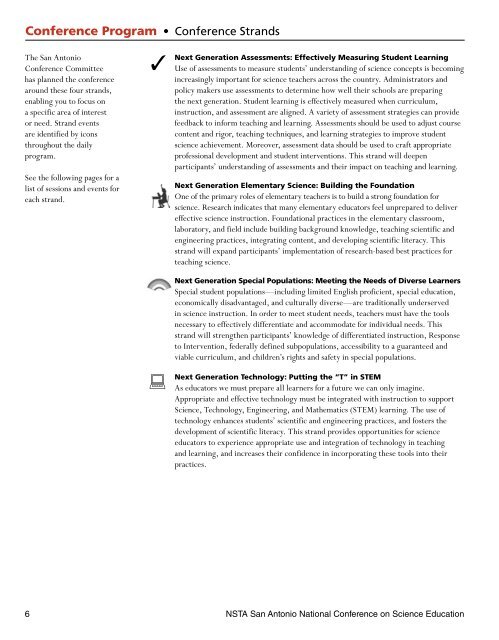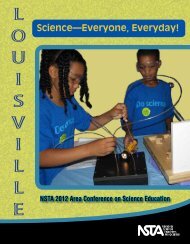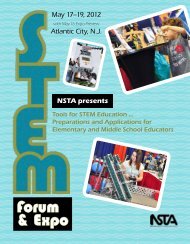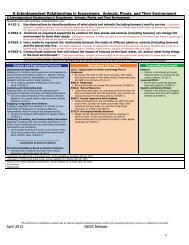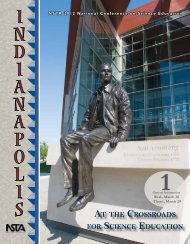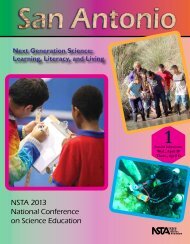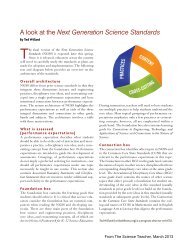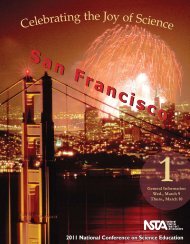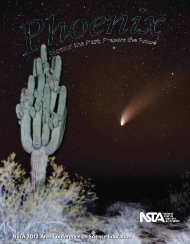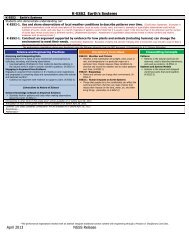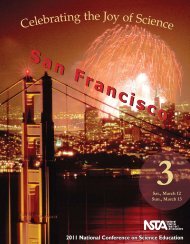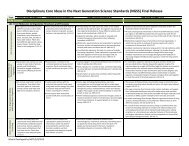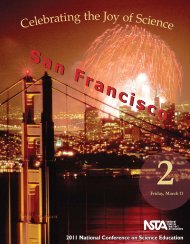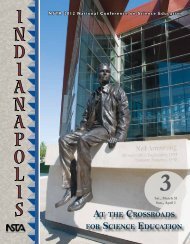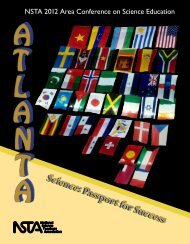NSTA 2013 National Conference on Science Education
NSTA 2013 National Conference on Science Education
NSTA 2013 National Conference on Science Education
Create successful ePaper yourself
Turn your PDF publications into a flip-book with our unique Google optimized e-Paper software.
<str<strong>on</strong>g>C<strong>on</strong>ference</str<strong>on</strong>g> Program • <str<strong>on</strong>g>C<strong>on</strong>ference</str<strong>on</strong>g> Strands<br />
The San Ant<strong>on</strong>io<br />
<str<strong>on</strong>g>C<strong>on</strong>ference</str<strong>on</strong>g> Committee<br />
has planned the c<strong>on</strong>ference<br />
around these four strands,<br />
enabling you to focus <strong>on</strong><br />
a specific area of interest<br />
or need. Strand events<br />
are identified by ic<strong>on</strong>s<br />
throughout the daily<br />
program.<br />
See the following pages for a<br />
list of sessi<strong>on</strong>s and events for<br />
each strand.<br />
<br />
<br />
Next Generati<strong>on</strong> Assessments: Effectively Measuring Student Learning<br />
Use of assessments to measure students’ understanding of science c<strong>on</strong>cepts is becoming<br />
increasingly important for science teachers across the country. Administrators and<br />
policy makers use assessments to determine how well their schools are preparing<br />
the next generati<strong>on</strong>. Student learning is effectively measured when curriculum,<br />
instructi<strong>on</strong>, and assessment are aligned. A variety of assessment strategies can provide<br />
feedback to inform teaching and learning. Assessments should be used to adjust course<br />
c<strong>on</strong>tent and rigor, teaching techniques, and learning strategies to improve student<br />
science achievement. Moreover, assessment data should be used to craft appropriate<br />
professi<strong>on</strong>al development and student interventi<strong>on</strong>s. This strand will deepen<br />
participants’ understanding of assessments and their impact <strong>on</strong> teaching and learning.<br />
Next Generati<strong>on</strong> Elementary <strong>Science</strong>: Building the Foundati<strong>on</strong><br />
One of the primary roles of elementary teachers is to build a str<strong>on</strong>g foundati<strong>on</strong> for<br />
science. Research indicates that many elementary educators feel unprepared to deliver<br />
effective science instructi<strong>on</strong>. Foundati<strong>on</strong>al practices in the elementary classroom,<br />
laboratory, and field include building background knowledge, teaching scientific and<br />
engineering practices, integrating c<strong>on</strong>tent, and developing scientific literacy. This<br />
strand will expand participants’ implementati<strong>on</strong> of research-based best practices for<br />
teaching science.<br />
Next Generati<strong>on</strong> Special Populati<strong>on</strong>s: Meeting the Needs of Diverse Learners<br />
Special student populati<strong>on</strong>s—including limited English proficient, special educati<strong>on</strong>,<br />
ec<strong>on</strong>omically disadvantaged, and culturally diverse—are traditi<strong>on</strong>ally underserved<br />
in science instructi<strong>on</strong>. In order to meet student needs, teachers must have the tools<br />
necessary to effectively differentiate and accommodate for individual needs. This<br />
strand will strengthen participants’ knowledge of differentiated instructi<strong>on</strong>, Resp<strong>on</strong>se<br />
to Interventi<strong>on</strong>, federally defined subpopulati<strong>on</strong>s, accessibility to a guaranteed and<br />
viable curriculum, and children’s rights and safety in special populati<strong>on</strong>s.<br />
Next Generati<strong>on</strong> Technology: Putting the “T” in STEM<br />
As educators we must prepare all learners for a future we can <strong>on</strong>ly imagine.<br />
Appropriate and effective technology must be integrated with instructi<strong>on</strong> to support<br />
<strong>Science</strong>, Technology, Engineering, and Mathematics (STEM) learning. The use of<br />
technology enhances students’ scientific and engineering practices, and fosters the<br />
development of scientific literacy. This strand provides opportunities for science<br />
educators to experience appropriate use and integrati<strong>on</strong> of technology in teaching<br />
and learning, and increases their c<strong>on</strong>fidence in incorporating these tools into their<br />
practices.<br />
6 <str<strong>on</strong>g>NSTA</str<strong>on</strong>g> San Ant<strong>on</strong>io <str<strong>on</strong>g>Nati<strong>on</strong>al</str<strong>on</strong>g> <str<strong>on</strong>g>C<strong>on</strong>ference</str<strong>on</strong>g> <strong>on</strong> <strong>Science</strong> Educati<strong>on</strong>


